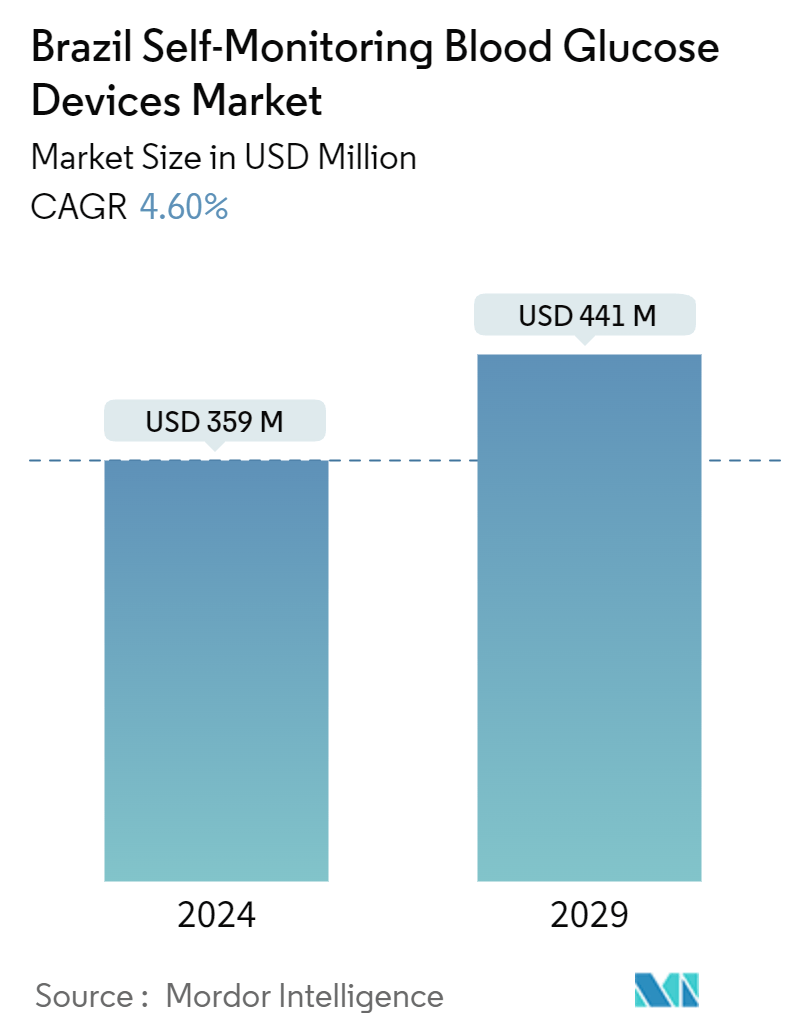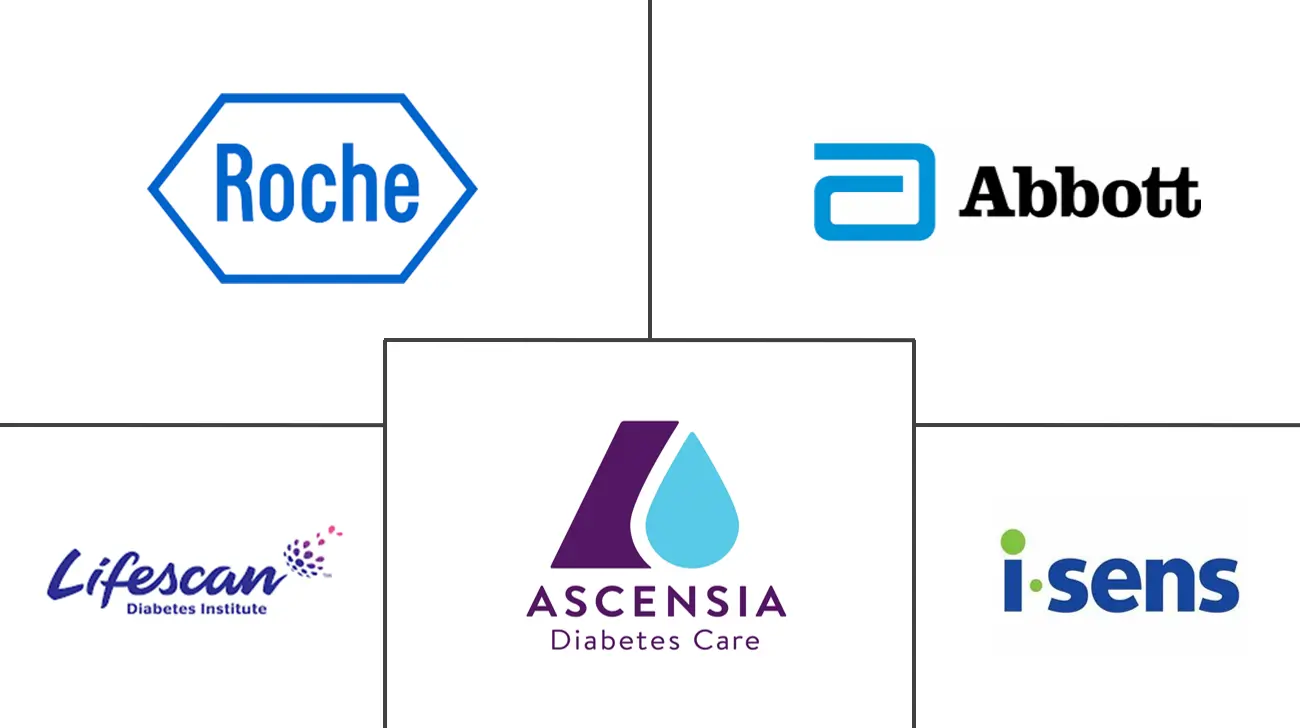Market Size of Brazil Self-Monitoring Blood Glucose Devices Industry

| Study Period | 2018 - 2029 |
| Base Year For Estimation | 2023 |
| Forecast Data Period | 2024 - 2029 |
| Market Size (2024) | USD 359 Million |
| Market Size (2029) | USD 441 Million |
| CAGR (2024 - 2029) | 4.60 % |
Major Players
*Disclaimer: Major Players sorted in no particular order |
Brazil Self-Monitoring Blood Glucose Devices Market Analysis
The Brazil Self-Monitoring Blood Glucose Devices Market size is estimated at USD 359 million in 2024, and is expected to reach USD 441 million by 2029, growing at a CAGR of 4.60% during the forecast period (2024-2029).
Continued elevation in blood glucose levels in diabetes patients can contribute to progressive complications such as renal, nerve, and ocular damage. The measurement of blood glucose helps in determining the effectiveness of blood glucose metabolism and guides in achieving optimal glucose control within the body. Over time, the readings provide the patient and their health professionals with the information required to determine the best management strategy for diabetes. Appropriate and timely monitoring of blood glucose allows the successful management of out-of-range blood glucose levels, minimizing diabetic-related health complications.
In Brazil, the public health system (Sistema Nico de Sade; SUS) has been progressively increasing the assistance available for individuals with diabetes. The Ministry of Health established a list of medications and supplies provided by the Brazilian Health System (SUS) to patients suffering from diabetes. However, their supply is usually not sufficient or recommended for optimal patient management across cities. The high prevalence of diabetes is associated with a significant economic burden.
Technological advancements in blood glucose meters, including cellular-connected devices that automatically upload SMBG data to secure cloud-based databases, allow for improved sharing and monitoring of SMBG data. Real-time monitoring of SMBG data presents opportunities to provide timely support to patients who are responsive to abnormal SMBG recordings. Such advantages can provide patients with poorly controlled T2D with the additional support needed to improve critical outcomes, thereby enhancing the market's prospects in the years to come.
Brazil Self-Monitoring Blood Glucose Devices Industry Segmentation
Self-monitoring of blood glucose is an approach used by diabetic patients to measure their blood sugar level themselves using a glucometer, test strips, and lancets. Based on the readings, patients can adjust or check the effect of their treatment. The Brazil self-monitoring blood glucose device market is segmented into components. The report offers the value (in USD) and volume (in units) for the above segments.
| Component | |
| Glucometer Devices | |
| Test Strips | |
| Lancets |
Brazil Self-Monitoring Blood Glucose Devices Market Size Summary
The Brazil self-monitoring blood glucose devices market is poised for growth, driven by the increasing prevalence of diabetes and the need for effective management strategies. The market is characterized by advancements in technology, such as cellular-connected devices that enhance data sharing and monitoring capabilities. These innovations are crucial in providing timely support to patients, particularly those with poorly controlled type-2 diabetes, thereby improving health outcomes. The Brazilian public health system has been expanding its support for diabetes patients, although challenges remain in the adequacy of supplies and medications. The economic burden of diabetes in Brazil is significant, with high healthcare costs associated with untreated or inadequately managed diabetes, leading to serious complications.
The market is fragmented, with major players like Abbott, LifeScan, Roche, and Ascensia holding significant shares. The test strip segment dominates the market due to its frequent use and continuous investment nature, contrasting with the one-time purchase of glucose meters. Brazil's healthcare reforms and partnerships with private companies aim to enhance the distribution of healthcare services and reduce costs, further supporting market growth. The market's expansion is also supported by research and real-world evidence demonstrating the effectiveness of connected devices in improving glycemic control. As the diabetes population in Brazil continues to grow, the demand for self-monitoring blood glucose devices is expected to rise, driving the market forward.
Brazil Self-Monitoring Blood Glucose Devices Market Size - Table of Contents
-
1. MARKET DYNAMICS
-
1.1 Market Overview
-
1.2 Market Drivers
-
1.3 Market Restraints
-
1.4 Porter's Five Forces Analysis
-
1.4.1 Bargaining Power of Suppliers
-
1.4.2 Bargaining Power of Consumers
-
1.4.3 Threat of New Entrants
-
1.4.4 Threat of Substitute Products and Services
-
1.4.5 Intensity of Competitive Rivalry
-
-
-
2. MARKET SEGMENTATION
-
2.1 Component
-
2.1.1 Glucometer Devices
-
2.1.2 Test Strips
-
2.1.3 Lancets
-
-
Brazil Self-Monitoring Blood Glucose Devices Market Size FAQs
How big is the Brazil Self-Monitoring Blood Glucose Devices Market?
The Brazil Self-Monitoring Blood Glucose Devices Market size is expected to reach USD 359 million in 2024 and grow at a CAGR of 4.60% to reach USD 441 million by 2029.
What is the current Brazil Self-Monitoring Blood Glucose Devices Market size?
In 2024, the Brazil Self-Monitoring Blood Glucose Devices Market size is expected to reach USD 359 million.

